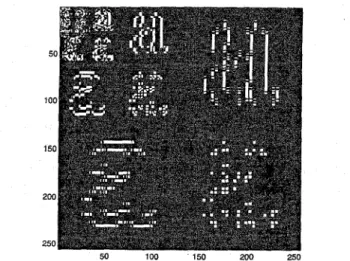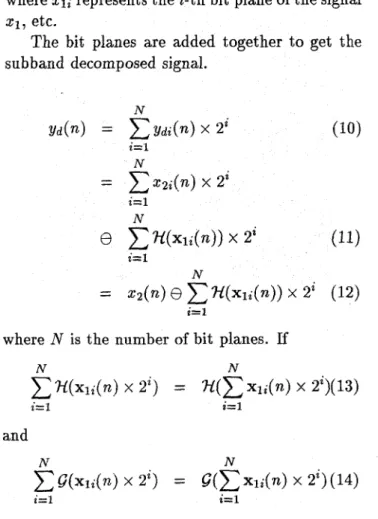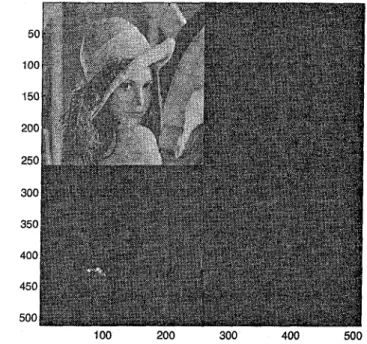A
MORPHOLOGICAL SUBBAND DECOMPOSITION STRUCTURE USING
GF(N)
ARITHMETIC
Metin Nafi Gurcan,
Omer
N . Gerek, A . Enis Getin
Bilkent University, Dept. of Electrical a n d Electronics Engineering, Bilkent,
Ankara TR-06533,
TurkeyE-mail:
gurcanaee.
bilkent.
edu. trPhone:
(90)
312-266 4307
Fax:(90) 312-266 4126
ABSTRACT
Linear filter banks with critical subsampling and perfect reconstruction (PR) property have re- ceived much interest and found numerous appli- cations in signal and image processing. Recently, nonlinear filter bank structures with P R and crit- ical subsampling have been proposed and used in image coding. In this paper, it is shown that PR nonlinear subband decomposition can be per- formed using the Gallois Field
(GF)
arithmetic. The result of the decomposition of an n-ary (e.g. 256-ary) input signal is still n-ary at different res- olutions. This decomposition structure can be uti- lized for binary and 2k(k
is an integer) level signal decompositions. Simulation studies are presented.1. INTRODUCTION
The subband decomposition is widely used in cod- ing and signal analysis. Traditionally, linear filters with
PR
property and critical subsampling are em- ployed for the decomposition. However nonlinear filters were not used for such purposes, mainly due t o the lack of frequency domain tools read- ily available for linear systems. Recently, some nonlinear subband decomposition structures withPR
and critical subsampling were proposed and used in image coding [l] - [4]. In these decompo- sitions, the key idea is t o replace the linear filters in a classical subband decomposition scheme with nonlinear filters.This work is supported by TUBITAK (Turkish Scien- COST tific and Technical Research Council) Grant No.
249, and NSF Grant No. INT-9406954.
In this paper it is shown that
PR
nonlinear subband decomposition can be performed using the Gallois Field(GF)
arithmetic. The result of the decomposition of an n-ary (e.g. 256-ary) input signal is still n-ary at different resolutions. With- out using the G F arithmetic, after one level of sub- band decomposition an image with with 256 gray levels ( 0 t o 255) produces subband images which have pixel values in the range [-255, 2551. The range increases as the number of levels increases. theory [5] - [SI. In [5] a framework for the wavelet transform of Finite Cyclic Groups was developed. In [6] this idea was specifically used for the binary decomposition of binary images. The generaliza- tion of wavelet decomposition and perfect recon- struction filter banks t o finite fields were also dis- cussed in [7, 81.In Section 2 nonlinear subband decomposition in GF(N) arithmetic is introduced. In Section 3
simulation examples are presented, and in Section
4 image analysis using bit planes is discussed. The
GF(N)
arithmetic is also used in the wavelet2. NONLINEAR DECOMPOSITION IN
. GF(N) ARITMETIC
The nonlinear subband decomposition of signal 2
is carried out using the structure shown in Figure
1. In this structure 7-l and
B
are nonlinear opera- tors, and they produce ya (analysis) and yd (detail) signals from the input signals z I ( n ) = z(2n - 1)and se(n)
=
$(an) [4]:Figure 1: n-ary Subband Decomposition Structure
where
and N I , N2, N 3 , AJ4 are positive integers.
The
PR
property of this nonlinear decomposi- tion structure is preserved if theGF
arithmetic is used. The results of the nonlinear operations have no effect on thePR
property as long as they pro- duce outputs in GF(N) because these are cancelled out in the synthesis part.For the above analysis equations, the corre- sponding synthesis equations are:
4(4
= Y a ( 4 - G ( Y d ( 4 ) (3) z L ( 4 = Y d ( 4+
7-l(x1(n)) (4) The following set of equations straightforwardly shows thatPR
property is preserved in theGF
arithmetic:
where
8,
@ represent the GF subtraction and ad- dition operations, respectively. Since z;(n)
is equal to z * ( n ) the nonlinear decomposition structure pro- videsPR
in the GF(N) arithmetic, as well.3. BINARY AND N-ARY SUBBAND
DECOMPOSITIONS
The binary subband decomposition of binary im- ages such as bit-plane images or textual images
50 100 150 200 250
Figure 2: Binary Subband Decomposition of the letter ’a’: Morphological Subband Decomposition
Figure 3: Binary Subband Decomposition of the letter ’a’: The Binary Wavelet Transform
can be accomplished by utilizing the nonlinear sub- band decomposition structure with the GF(2) arith- metic. Figure 2 illustrates the binary decomposi- tion of the letter “a”; Figure 3 shows the binary wavelet decomposition (BWT) of the same image. The ringing effects present in the
BWT
disappear in the nonlinear subband decomposition.It is possible t o develop lossless binary coding methods based on binary decomposition structure. In one such method, subband images are encoded using embedded zero-tree coding and entropy cod- ing [9].
Figure 4 shows the subband decomposition of
512x512 Lena image which has 256 gray levels.
The decomposition is obtained using the nonlin- ear structure depicted in Figure 1 and by taking
7-l(xl(n)) =
median(xl(n))
and B(yd(n))=
0.This case corresponds t o the nonlinear decompo- sition structure developed by Egger and Kunt [l]
performed in the GF(N
=
256) arithmetic. The low-low subband image is obtained by directly down- sampling the image. Ringing effects present in linear-filter decompositions do not appear in the low-high, high-low, and high-high subimages. This may especially be useful for pattern matching ap- plications in subbands.Another application is lossless image compres- sion. For instance, the most signilkant bit plane of the 256x256 Lena image could be Iosslessly com- pressed 3.01 times after nonlinear subband decom- position whereas the Lempel-Ziv coding resulted in a compression ratio of 2.44 [9]. This finite field decomposition structure can also be extended t o coding k (e.g. 256) level images provided that the
GF(k)
arithmetic can be performed.4. BIT PLANE SUBBAND
DECOMPOSITION
A
2k level signal decomposition can be parallely implemented in bit planes, which can be utilized in some VLSI implementations. In this section conditions for the parallel implementation are de- scribed.Nonlinear subband decomposition in bit planes is achieved by first dividing the 2k level signal into
k
bit planes and then decomposing each bit plane separately in parallel. Finally, the outputs of the decompositions are combined together t o obtain the 2k level decomposition.The sub-signal obtained by combining the bit planes is not always equivalent t o the sub-signal obtained by direct subband decomposition. The necessary conditions for the equivalence can be developed as follows. Consider the nonlinear sub- band decomposition procedure of Section 2.
If
we repeat the procedure for each bit plane then we get:where zli represents the i-th bit plane of the signal 21, etc.
The bit planes are added together t o get the subband decomposed signal.
N
i=l
N
=
x 2 ( n )e
'H(x&))
x 2i (12) i=lwhere N is the number of bit planes. If
N N
and
N N
then the direct subband decomposition and sub- band decomposition in bit planes will yield the same decomposed signals. This condition is sat- isfied for some filters such as median filters. One additional advantage of using median type filters is that the output of such filters can be efficiently computed if the input signal is binary. This can be accomplished by first summing the signal values of the input to the median filter and then comparing the sum with a threshold which is set a t half the input signal length. If the sum is greater than the threshold the output is one, otherwise it is zero.
The decomposition structure can be extended t o two-dimensions for the rectangular and quin- cunx sampling cases. For this purpose separable filters can be used and the input signal is filtered horizontally and vertically by these filters. An- other possibility is t o use two dimensional filters. Figure 5 shows an example region of support for such filtering.
i o 0 200 300 400 500
Figure
4:
256-ary Subband Decomposition of Lena Image5. CONCLUSION
In this paper we present a nonlinear subband de- composition structure employing the
GF( N )
arith- metic. The subband images in this structure pre- serve the gray-scale level of the original image. The decomposition structure results in binary (256 gray level) subband images for binary (256 gray level) images. It is possible to parallelize the de- composition structure in the GF(N) arithmetic for certain types of nonlinear filters in bit planes. This results in an efficient realization of the nonlinear subband decomposition.6. REFERENCES
[l] 0. Egger,
M.
Kunt, “Embedded Ze- rotree Based Lossless Image Coding,” IEEE ICIP’95, vol. I1 pp. 616-619., June 1995.[2]
D. E. F.
Florencio,R.
Schafer “Perfect Reconstructing Nonlinear Filter Banks,” inICASSP’96, 1996.
[3]
R. L.
de Queiroz, D. A.F.
Florencio,“A
Pyramidal Coding Using a Nonlinear Filter Bank,” in ICASSP’96, 1996.
REGION OF SUPPORT
CURRENT PIXEL
Figure 5: Region of Support for two dimensional nonlinear filtering
[4] F. J. Hampson,
J.
C. Pesquet, “A Nonlinear Subband Decomposition with Perfect Recon- struction,” in ICASSP’96, 1996.[5]
G.
Caire,R.
L.
Grossman,H .
V.
Poor,“Wavelet Transforms Associated with Finite Cyclic Groups,’’
IEEE
Transactions on Infor- mation Theory, vol. 39, No. 4, July 1993. [6] NI.D.
Swanson and A.H .
Tewfik, “A BinaryWavelet Decomposition of Binary Images,” Submitted t o IEEE Trans. Image Processing
(IP-941).
[7]
P.P.
Vaidyanathan, “Unitary and Parauni- tary Systems in Finite Fields,” in Proc. 1990 IEEE Int. Symp. on Circuits and Systems,New Orleans, LA, pp. 1189-1192,1990.
[S] P.P. Vaidyanathan, Multirate Systems and Filter Banks, Englewood Cliffs, N.J, Prentice
Hall,
1992.[9] M. N. Giircan, 0. N. Gerek, A. E. Cetin, “Bi- nary Morphological Subband Decomposition For Image Coding,” TFTS-Symposium, 1996.


